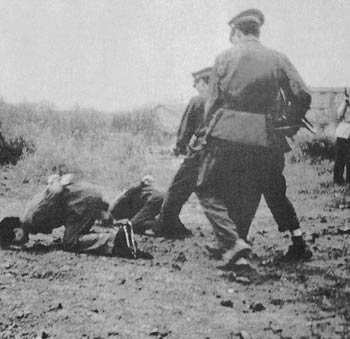Communist China’s Control over East Turkestan
As we have seen, there are many economic reasons why East Turkestan is very important to China. That country's interest in east Turkestan goes back thousands of years and the region has frequently been occupied by China, either fully or in part.
The latest Chinese occupation, that is still in existence today, began in the middle of the 1700s. The civil conflicts in East Turkestan in the seventeenth and eighteenth centuries not only damaged popular unity, but also weakened the state itself. At the same time, the Manchus came to power in China and the Manchu dynasty began. Throughout their rule, East Turkestan was run by centrally appointed governors and bureaucrats. In 1911 the Manchu Empire was overthrown and replaced by the Chinese Republic under Sun Yat Sen, the leader of the Kuomintang party, and East Turkestan was totally enslaved.
The cruelty inflicted on the people of East Turkestan by the Kuomintang regime led to a popular uprising and a declaration of independence in 1931. Up until then, the Muslims of East Turkestan, aware of the political realities of the time, avoided any initiatives aimed at securing independence. It was not only China that had its sights set on the region, but Soviet Russia was also waiting for an opportunity to take it over. The people of East Turkestan were aware of this (and of the sufferings the Russians had inflicted on the Muslims of West Turkestan) and for this reason preferred to accept the status quo rather than fall into communist hands. However, the 1931 move towards independence left the Muslims facing the very threat they had feared. China was able to put the movement down only with help from Soviet Russia, and a large part of the region came under Soviet control.
 |
| Mao saluting his army after the communists had captured Beijing. |
That interesting outcome was the result of a number of developments: China realized that it would be unable to quell the East Turkestan uprising on its own, and signed a secret agreement with Soviet Russia. As a result it acquired weapons and troops from the Russians. Despite this move, however, it still proved impossible to put the uprising down. In 1933, the Red Army invaded East Turkestan by land and defeated the Muslim forces. Following a number of battles in 1934-1937, East Turkestan found itself under de facto Soviet rule. The savagery and oppression inflicted on the peoples of the Soviet republics were now visited on the Muslims of East Turkestan. The Red Army carried out mass killings, tore down mosques, and even raped women.
With the outbreak of the Second World War, the Russians withdrew their forces from East Turkestan. As the nationalist Chinese government was defeated by Mao's communist guerillas in various regions of the country, it fled to Formosa (Taiwan). China fell to the communists, and East Turkestan with it.
Within the course of that process, the people of East Turkestan once more made a bid for independence, and the independent Republic of East Turkestan was declared in 1944, though it only lasted until Mao took control of China in 1949.
The "Red" Age in East Turkestan
 |
The first communist government in the world came to power in Russia. The Muslims of East Turkestan closely followed the developments in West Turkestan (Kazakh, Uzbek, Kyrgyz, Turkmen and Tajik) territories under Soviet domination, with which they shared common borders and historical, religious, ethnic and cultural links. In particular, those such as the late Isa Yusuf Alptekin (who served in West Turkestan and witnessed the communist Russian oppression at first hand), warned both the Chinese government and the Muslims of East Turkestan against the communist menace. It was a common communist tactic to pay lip service to such concepts as equality, social justice and the freedoms of nations until they came to power, at which time things change. Equality would be replaced by the orders of the Politbureau, social justice by exploitation, and freedoms by expulsions, torture, labor camps, and mass executions.
Indeed, those same developments were experienced in East Turkestan. At the 7th Congress in 1945, before coming to power, Mao declared that when the communists did come to power, they would allow different ethnic groups to determine their own futures and establish their own administrations.23As soon as they came to power, however, they ignored those promises and declared:
"For two thousand years Xinjiang has been an inalienable part of an indivisible China; therefore, there would be no sense in dividing China into federated republics; this is a demand hostile to history and socialism…"24
 |
| The communists slaughtered thousands of innocent people during their takeover in China. |
Cruelty and oppression followed. First, the leaders of the Republic of East Turkestan were martyred in a mysterious plane crash on their way to a meeting with Chairman Mao. Later, the Red Chinese government, which regarded East Turkestan as part of its own territory (and was unwilling to let it go) set about ruthlessly martyring the Muslim population. The first war was waged against the Muslims' beliefs. Schools providing religious instruction were closed, religious leaders were arrested, and the majority of them were martyred. Portraits of Mao and Communist Party flags were hung up in mosques, and Muslims were ordered to show them due respect. Some Muslims were arrested and executed on the pretext of being pan-Turkish, others of being pan-Islamic. Another aspect of the repression was forced exile. Many Muslims who were forced off their lands died en route because of the weather conditions. Between 1949 and 1952, 2.8 million East Turkestan Muslims were martyred by various means. The figure was 3.5 million between 1952 and 1957, 6.7 million between 1958 and 1960, and 13.3 million between 1961 and 1965.
 |
| Oppression, slaughter and torture are integral parts of the communist regime. Scenes of this savagery against the Muslims of East Turkestan are also frequently witnessed in China itself.. |
 |  |
As the Muslims were being systematically exterminated, Chinese were brought in to replace them in an attempt to prevent Muslims' rightful claims to their own land. Another method employed by the Mao regime, which wanted to turn East Turkestan into a province of China, was "family planning" by means of forced abortions. This communist brutality, which is still going on today, will be considered in more detail in subsequent chapters of this book.
Prominent Names in East Turkestan's Struggle for Freedom | |
| The beginning of the twentieth century was a time when national and spiritual feelings in East Turkestan began to stir. This "national awakening" of the Uighur Turks came about by means of Abdulqadir Damulla, who began his activities following a trip to Muslim countries such as Turkey, Egypt and Syria. One of the most important needs of the time was for the people to be made aware of their sacred values and historical heritage. Damulla opened a school called the Matla'ul Hidayat, and began to teach the young people of East Turkestan about their history, as well as helping to raise the popular consciousness by means of the books he published. Following Damulla, the struggle in East Turkestan was taken on by the "the Three Masters," Isa Yusuf Alptekin, Muhammed Emin Bugra, and Mesud Sabri Baykuzu. Baykuzu's struggle ended with his arrest by the communist Chinese administration in 1951 (and he was martyred by lethal injection the following year). Alptekin and Bugra continued the struggle until the very end of their lives.
Alptekin served as the secretary of the East Turkestan Provincial Government, itself subordinate to China, and spent his whole life speaking about the rightful claims of East Turkestan on international platforms and trying to free the Muslims. He started working at the Chinese Consulate in West Turkestan at the age of 26. This was a time when the Soviet oppression of the Turkish Muslims of West Turkestan was at its height, and saw the start of Alptekin's struggle as he witnessed communist mentality and practice first hand. Throughout his time in West Turkestan, he established contacts with people who supported independence for East Turkestan (but had to carry out his activities in secret). One of the subjects Alptekin was most concerned with was protecting the people from communism. He even made contacts within the Chinese government in the belief that this would enable him to operate more effectively against communism. He also represented his country at the Chinese parliament between 1936 and 1945. When the communists first seized Beijing and then marched towards East Turkestan, Alptekin was forced to abandon his country. In 1954 he settled in Istanbul and began to work from there. He traveled to many countries in order to tell the world about the suffering in East Turkestan, and to host conferences, attend panels, and give speeches at universities. Muhammed Emin Bugra's name went down in the history of the East Turkestan struggle with his extensive work Dogu Turkistan Tarihi (The History of East Turkestan). He personally served in the 1931 independence movement, and was instrumental in freeing such cities as Hotan and Yarkent from Chinese occupation. He served as a minister in the East Turkestan state established in 1944, and sought asylum in India shortly before the Chinese invasion. From there he moved to Turkey, and carried on the fight from there. The lifelong struggle waged with honor by these patriots is still going on today. There are currently some 20 associations and organizations active on East Turkestan's behalf in the international arena. These all work together under the umbrella of the East Turkestan National Council (ETNC), and are working to have the voice of the people of East Turkestan heard by the outside world. |
- Foreword: Only The Turkish-Islamic Union Can Halt The Bloodshed
- Uyghurs and Chinese Can Live Together in PeaceiIn East Turkestan
- Why is the Founding of the Turkish-Islamic Union a Matter of Such Urgency?
- What Will the Turkish-Islamic Union Bring to Muslims?
- Union and Unity Will Strengthen the Turkish–Islamic World
- What Form Should the Turkish-Islamic Union Take?
- A Call to the Turkish-Islamic World
- The Solution to the Sufferings of Muslims in East Turkestan Is the Turkish-islamic Union
- Introduction
- China: A State of Fear
- East Turkestan: A Crossroad of Civilizations
- Communist China’s Control over East Turkestan
- Chinese Torture in East Turkestan
- The Communist Party's Policy of Oppression
- Conclusion

